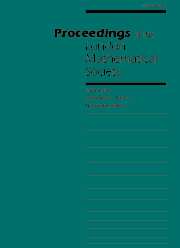Conditions for the solvability of systems of two and three additive forms over p-adic fields
Published online by Cambridge University Press: 19 October 2005
Abstract
This paper is concerned with non-trivial solvability in $p$-adic integers of systems of two and three additive forms. Assuming that the congruence equation $a x^k + b y^k + c z^k \equiv d \,(\mbox{mod}\,p)$ has a solution with $xyz \not\equiv 0\,(\mbox{mod}\,p)$ we have proved that any system of two additive forms of odd degree $k$ with at least $6 k + 1$ variables, and any system of three additive forms of odd degree $k$ with at least $14 k + 1$ variables always has non-trivial $p$-adic solutions, provided $p$ does not divide $k$. The assumption of the solubility of the congruence equation above is guaranteed for example if $p > k^4$.
In the particular case of degree $k = 5$ we have proved the following results. Any system of two additive forms with at least $n$ variables always has non-trivial $p$-adic solutions provided $n \geq 31$ and $p > 101$ or $n \geq 36$ and $p > 11$. Furthermore any system of three additive forms with at least $n$ variables always has non-trivial $p$-adic solutions provided $n \geq 61$ and $p > 101$ or $n \geq 71$ and $p > 11$.
Information
- Type
- Research Article
- Information
- Proceedings of the London Mathematical Society , Volume 91 , Issue 3 , November 2005 , pp. 545 - 572
- Copyright
- 2005 London Mathematical Society
Footnotes
- 1
- Cited by

